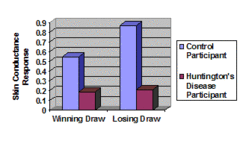Huntington’s Disease (HD) is defined as a genetic neurodegenerative disorder with middle-aged onset. Symptoms include involuntary muscle movements and deterioration of cognitive processes and memory. As a result of the changes in cognitive processes, the development of HD can increase risky decision-making. This risky shift can in turn be associated with poor performance on gambling tasks (see WAGER 6(24), or Stout, Rodawalt, & Siemers, 2001). This week, The WAGER reviews research that used HD as a model to examine the role of the autonomic nervous system in risky decision-making (Campbell, Stout, & Finn, 2004). More specifically, this study examined skin conductance responses to gambling and gambling outcomes in participants with and without HD.
Campbell and her colleagues recruited 15 patients with HD (11 male) and 16 (6 male) control participants for this study. Potential participants were excluded if they had recent/current substance abuse, neurological illnesses other than HD, a major psychiatric disorder diagnosis, less than an 8th grade education, glandular disorders, or prior participation in the authors’ gambling studies. Participants engaged in a computerized version of the Simulated Gambling Task (SGT)1. In this task, individuals encounter four decks of 40 cards each from which to draw. After each draw, participants learn how much they won or lost. Two of the decks have smaller payouts for each win, but end in a net win (i.e., win deck) and two decks have larger payouts for each win, but end in a net loss (i.e., loss deck). The study participants gambled with simulated money, but were told they would receive $10 if they were successful on the task (i.e., made at least $2000 in simulated dollars).
To examine the link between decisions and autonomic responses, the authors measured individuals’ card draws from the “win” and “loss” decks and their skin conductance responses (SCR) (e.g., sweating). Specifically, after determining each participant’s resting SCR (baseline), they measured change in SCR from 1) baseline to pre-card selection; 2) baseline to post-card selection; and 3) baseline to post-card outcome. They also included the type of deck (i.e., “win deck” or “loss deck”) from which participants selected, and the draw outcome (i.e., win or loss) as independent measures.
Figure 1. Skin Conductance responses to wins and losses by group (2)
Performance on the SGT replicated the results of an HD study previously summarized in WAGER 6(24): participants with HD failed to increase the number of advantageous selections over repeated trials, selecting fewer cards from “win” decks than did control participants. The SCRs for HD participants before selection, after selection, and after learning the outcome, independent of deck or outcome type, showed less change from baseline than did the SCRs of control participants. A repeated measures ANOVA revealed an interaction between group (i.e., HD vs. control) and time (pre- vs. post- card selection), F(1,24) = 8.51, p < 0.01. The SCR change from baseline prior to and after card selection did not differ in participants with HD, but was greater post-selection (particularly post-“loss deck” selection) than pre-selection for control participants. Finally, as Figure 1 shows, participants with HD did not differ in SCR change from baseline in response to wins or losses, t(14) = -1.66, p > 0.12, but controls showed greater SCR increases after losses than wins, t(15) = -3.34, p < 0.005.
Overall, this study showed that participants with HD selected the riskier deck more often than control participants and also had less fluctuation in their SCRs in anticipation of, and in response to, their selections. Control participants, whose selections were less risky overall, showed increased SCRs after choosing a card from the risky deck, and also exhibited greater SCRs after learning they had lost than after learning they had won.
This study is one of the first to illuminate the relationship between physiological stress responses and risky decision-making. It implies that the lack of a skin conductance response to losses or anticipated losses might contribute to making more risky decisions and possibly interfere with learning less risky and more personally beneficial decision strategies. However, because participants with HD differ from other participants in more than their gambling behavior, we cannot say conclusively that blunted SCRs relate to risky decision-making; for example, HD patients might have blunted SCRs as a symptom independent of their decision-making abilities. The small sample size and potentially confounding difference in gender composition of the groups also limit our ability to generalize the findings beyond this sample.
Nevertheless, this research contributes to an increased understanding of the factors that contribute to risk-taking and ultimately disordered behavior (e.g., pathological gambling). Future research might investigate whether the findings are specific to HD or people who take risks in general, whether people with gambling problems have blunted SCRs to gambling decisions, and whether the observed blunted SCRs indicate a specific underlying psychological problem such as depression or impulsivity.
Comments on this article can be addressed to Sarah Nelson. Article co-authored by Rachel Kidman.
Notes
1 Authors derived this from the Bechara Gambling Task (Bechara, Damasio, Damasio, & Anderson, 1994).
2 Approximation of Figure 3 in Campbell et al., 2004.
References
Bechara, A., Damasio, A. R., Damasio, H., & Anderson, S. W. (1994). Insensitivity to future consequences following damage to human prefrontal cortex. Cognition, 50, 7-15.
Campbell, M. C., Stout, J. C., & Finn, P. R. (2004). Reduced autonomic responsiveness to gambling task losses in Huntington’s disease. Journal of the International Neuropsychological Society, 10(2), 239-245.
Stout, J. C., Rodawalt, W. C., & Siemers, E. R. (2001). Risky decision making in Huntington’s disease. Journal of the International Neuropsychological Society, 7, 92-101.





